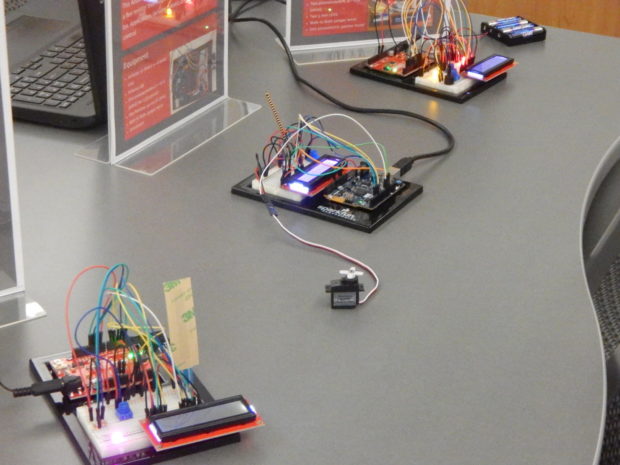

Electronics on display at one of the Makerspace bays where students can create. | Jakob Walker/The Cougar
The MD Anderson Library held a grand opening Friday for the brand new Makerspace center that will give students the tools to create simple electronics inside the space.
The Makerspace is an area where students can learn about technology and create simple electronic projects on their own or with the assistance of one of the student employees. The center is open to any student and has workshops to help students learn how to create their projects.
Chairman of the Department of Computer and Electrical Engineering, Badri Roysam, said it was a challenge to get the right equipment for the center and make it work in a library setting, where any student from any major can walk in and try out the center.
“Suppose that a dance major wants to wear some lights that blink a certain way,” Roysam said. “She may not know how to do such a thing, but a computer major might. So we want to spark collaboration.”
The Makerspace first entered the planning stage two years ago, Roysam said.
“It took us a while to really figure out how to do it right and obtain all the resources,” Roysam said.
At the grand opening, students were able to view project displays and examples of what they could create. On display was a temperature sensor and a robot that can tell whether it’s about to run into a wall using sensors that detect distance.
Students can check out kits and books containing steps on how to create something small. Many of the featured kits worked with the computer hardware system Arduino. Students can find step-by-step instructions on building the kits by navigating to the Makerspace website.
If a student needs help creating something, they can meet with a student employee at the Makerspace center.
“Makerspace is designed for people who have never written or seen code,” said Ali Alrifai, an electrical and computer engineering senior and student employee at Makerspacei. “Our program here is for people like that. We have kits that they can take home for two weeks, and they can learn how to code them.”
The future of the Makerspace is entirely dependent on student desire, Roysam said. While some of the ideas include projects with drones, it will ultimately be up to the student population to decide what they would like to see next.
“Over time, we expect to add more and more things to (the Makerspace),” Roysam said. “What we want is for the students to tell us what they want to do next, and then we will find the money to buy those things.”
Classes taught by the Makerspace happen on a monthly basis. March classes will include Photoshop courses, web design courses, Arduino courses and an introduction to 3D printing. Students wishing to register for these classes can register online through the UH Library Calendar.
“Through our website, people can recommend new classes,” Makerspace manager Chris Holthe said.
He said based on popularity and student desire, five or six classes may be added each month on top of repeating courses such as the Photoshop and Excel courses.
The Makerspace bay schedule can be found on the Makerspace library page. The center can be found on the first floor of the MD Anderson Library within the Learning Commons.
news@thedailycougar.com
—
“Library’s Makerspace bays help students create simple electronics” was originally posted on The Daily Cougar
